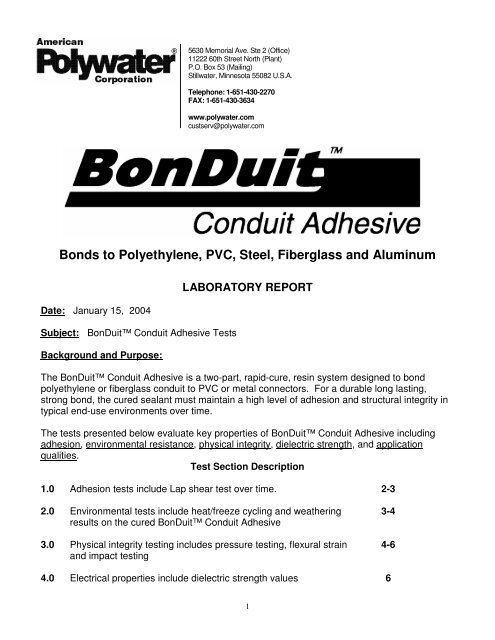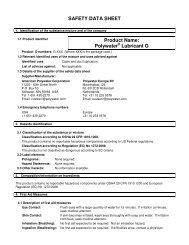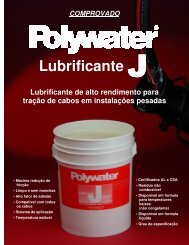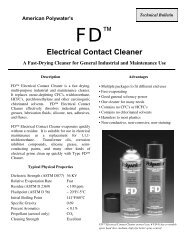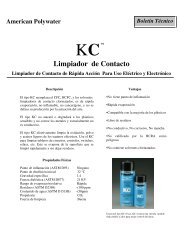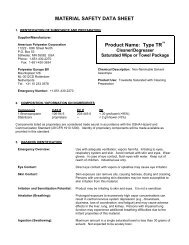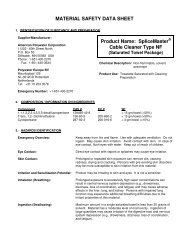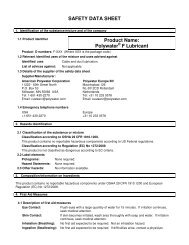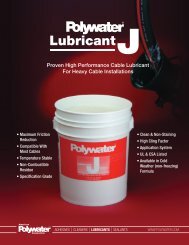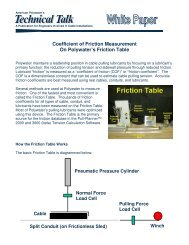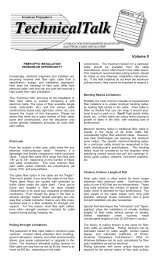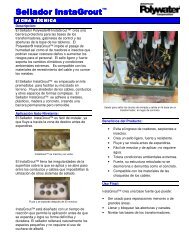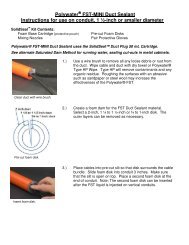Bonds to Polyethylene, PVC, Steel, Fiberglass and Aluminum
Bonds to Polyethylene, PVC, Steel, Fiberglass and Aluminum
Bonds to Polyethylene, PVC, Steel, Fiberglass and Aluminum
Create successful ePaper yourself
Turn your PDF publications into a flip-book with our unique Google optimized e-Paper software.
5630 Memorial Ave. Ste 2 (Office)11222 60th Street North (Plant)P.O. Box 53 (Mailing)Stillwater, Minnesota 55082 U.S.A.Telephone: 1-651-430-2270FAX: 1-651-430-3634www.polywater.comcustserv@polywater.com<strong>Bonds</strong> <strong>to</strong> <strong>Polyethylene</strong>, <strong>PVC</strong>, <strong>Steel</strong>, <strong>Fiberglass</strong> <strong>and</strong> <strong>Aluminum</strong>Date: January 15, 2004Subject: BonDuit Conduit Adhesive TestsBackground <strong>and</strong> Purpose:LABORATORY REPORTThe BonDuit Conduit Adhesive is a two-part, rapid-cure, resin system designed <strong>to</strong> bondpolyethylene or fiberglass conduit <strong>to</strong> <strong>PVC</strong> or metal connec<strong>to</strong>rs. For a durable long lasting,strong bond, the cured sealant must maintain a high level of adhesion <strong>and</strong> structural integrity intypical end-use environments over time.The tests presented below evaluate key properties of BonDuit Conduit Adhesive includingadhesion, environmental resistance, physical integrity, dielectric strength, <strong>and</strong> applicationqualities.Test Section Description1.0 Adhesion tests include Lap shear test over time. 2-32.0 Environmental tests include heat/freeze cycling <strong>and</strong> weatheringresults on the cured BonDuit Conduit Adhesive3.0 Physical integrity testing includes pressure testing, flexural strain<strong>and</strong> impact testing3-44-64.0 Electrical properties include dielectric strength values 61
1.0 Adhesion Tests:1.1 Lap Shear Test(Modification of ASTM D 1002 St<strong>and</strong>ard Test Method for Apparent Shear Strengthof Single-Lap-Joint Adhesively Bonded Metal Specimens by Tension Loading)The ASTM D 1002 test measures the internal shear strength of adhesives. The shear strengthadhesion characteristics of BonDuit Adhesion were measured on different substrates. Shearstrength is the force needed <strong>to</strong> pull apart the bond of overlapping substrates. This can becompared <strong>to</strong> the tensile strength of a coupling. The adhesion force is dependent on <strong>to</strong>tal area ofbond.0.4-inch by 6-inch strips were obtained from the following materials: BlueDiamond schedule 40 polyethylene innerduct (1.25 inch), fiberglass conduit(2 inch), galvanized steel plate, aluminum plate <strong>and</strong> schedule 40 <strong>PVC</strong>connec<strong>to</strong>r (1 ¼-inch). All surfaces were s<strong>and</strong>ed with 80 grit aluminumabrasive cloth <strong>and</strong> cleaned with a TR-1 Cleaning Wipe <strong>to</strong> removecontaminates. A ¼-inch bead of BonDuit Conduit Adhesive was applied <strong>to</strong>the edge of the polyethylene or fiberglass strip. The second strip is slid overthe bonding surface as if it were being placed in<strong>to</strong> a connec<strong>to</strong>r. Any excessadhesive is trimmed from the edges of the bonded strips <strong>and</strong> the joint is agedaccording <strong>to</strong> the conditions listed below.For the adhesive shear test, the strip is clamped in<strong>to</strong> a pulling device <strong>and</strong> pulled apart at a rateof two inches per minute. Pulling force readings are the maximum force before breaking. Thevalue shown is the average of three pulls. These values may vary with application technique,field conditions <strong>and</strong> the actual material.Aging ConditionAir Control Ambient Temperature50° C WaterImmersionMaterials 1 hours 24 hours 1 week 1 month 1 weekHDPE <strong>to</strong> <strong>PVC</strong> 242 lbs/in 2 277 lbs/in 2 276 lbs/in 2 343 lbs/in 2 312.6 lbs/in 2HDPE <strong>to</strong> <strong>Steel</strong> 298 lbs/in 2 557 lbs/in 2 613 lbs/in 2 571 lbs/in 2 488 lbs/in 2HDPE <strong>to</strong> <strong>Aluminum</strong> 254 lbs/in 2 332 lbs/in 2 391 lbs/in 2 395 lbs/in 2 441.6 lbs/in 2HDPE <strong>to</strong> <strong>Fiberglass</strong> 181 lbs/in 2 189 lbs/in 2 239 lbs/in 2<strong>Fiberglass</strong> <strong>to</strong> <strong>Steel</strong> 294 lbs/in 2 528 lbs/in 2 600+ lbs/in 2<strong>Fiberglass</strong> <strong>to</strong> <strong>PVC</strong> 201 lbs/in 2 119 lbs/in 2 141 lbs/in 2Peak adhesion was reached after 7 days of cure. The <strong>PVC</strong> strip routinely broke during testingindicating that the bond was stronger than the <strong>PVC</strong> itself.1.2 Pipe Adhesion TestThis test mimics the real world tensile strength of the connec<strong>to</strong>r <strong>and</strong> innerduct.2
A 1 ¼-inch <strong>PVC</strong> connec<strong>to</strong>r (with 1-inch of insert) was bonded <strong>to</strong> a 1 ¼-inch HDPE innerduct.The interior bonding surface of the <strong>PVC</strong> connec<strong>to</strong>r <strong>and</strong> the exterior of the HDPE innerduct weres<strong>and</strong>ed with 80-grit abrasive cloth <strong>and</strong> then cleaned with the TR Cleaning Wipe beforebonding.After the surface was prepared, the BonDuit Conduit Adhesive was applied as a ¼ inch beadline along the outside edge of the HDPE innerduct. The connec<strong>to</strong>r was twisted on, spreading athin layer of adhesive throughout the connection. The BonDuit Conduit Adhesive is cured <strong>and</strong>aged according <strong>to</strong> the listed condition. The innerduct was attached <strong>to</strong> a stationary fitting <strong>and</strong> theconnec<strong>to</strong>r was attached <strong>to</strong> a load cell with winch attachment. The maximum pulling force wasrecorded. The results below are an average of three trials.24 hours 7 daysMaterial Total Lbs Lbs per Inch 2 Total Lbs Lbs per Inch 2<strong>PVC</strong>/HDPE 801 204 1000+ * 255* The load cell used in this testing is limited <strong>to</strong> 1,000 lbs.Results may vary with application technique <strong>and</strong> condition. The results from this test arecomparable <strong>to</strong> the lap shear testing reported in Section 1.1. The BonDuit Conduit Adhesiveshows consistently good adhesion <strong>to</strong> polyethylene <strong>and</strong> <strong>PVC</strong>.2.0 Environmental Testing2.1 Heat Freeze Cycling TestingThe cured BonDuit Conduit Adhesive bond should withst<strong>and</strong> temperature extremes.Temperature cycling measures adhesion under this type of environmental condition. This is ameasurement of the substrate adhesion during the expansion <strong>and</strong> contraction of materials underdifferent temperature extremes.BonDuit Conduit Adhesive is applied <strong>to</strong> a 0.4-inch by 6-inch polyethylene strip <strong>and</strong> a 0.4-inchby 1.25-inch insert <strong>PVC</strong> connec<strong>to</strong>r. The bond was prepared as described in the lap shear testmethod. The samples were cured at room temperature for 1 hour. The samples were aged inan air circulating oven at 50° C <strong>and</strong> a freezer set at -15° C for a minimum of four hours. Thesamples were aged for 10 cycles over 1 month. The lap shear adhesion test was thenperformed.Results:Materials BondedAdhesion Strength<strong>PVC</strong> <strong>to</strong> HDPE 295 lbs/inch 2These results compare favorably <strong>to</strong> the lab shear adhesion results with ambient air <strong>and</strong> waterimmersion aging testing. There were no signs of degradation of the BonDuit ConduitAdhesive after 10 temperature cycles between 50 o <strong>to</strong> -15 o C.3
2.2 Weathering TestingBonDuit Conduit Adhesive was applied <strong>to</strong> polyethylene <strong>and</strong> <strong>PVC</strong> connec<strong>to</strong>r using st<strong>and</strong>ardinstructions. The surface was prepared by s<strong>and</strong>ing <strong>and</strong> cleaning with TR Cleaner Wipes.BonDuit Conduit Adhesive was cured for 1 hour then placed on the roof of AmericanPolywater.Temperatures ranged from -10 o <strong>to</strong> 80 o F. Conditions include rain, snow <strong>and</strong> sleet as well asexposure <strong>to</strong> sun <strong>and</strong> UV. After 3 month there has been no deterioration of BonDuit ConduitAdhesive. The bond can not be broken by prying with a screwdriver. There is no visible sign ofseparation on any of the surfaces. BonDuit Conduit Adhesive has a slight green-greydiscoloration on the surface (
3.2 Impact Testing (Modification of ASTM G 14; Impact Resistance of PipelineCoatings)Impact testing is important for the BonDuit Conduit Adhesive as itindicates a resistance <strong>to</strong> dropped <strong>to</strong>ols <strong>and</strong> other unknown, sharpimpacts <strong>to</strong> the joint.In this test a 1/2-inch steel ball <strong>and</strong> rod with a weight of threepounds is dropped from varying heights <strong>to</strong> establish the impactresistance of the BonDuit Conduit seal. The test fixture isdesigned such that the steel ball <strong>and</strong> rod drops in a straight free fallthrough a drop tube. The BonDuit Conduit Adhesive is appliedaccording <strong>to</strong> instructions <strong>and</strong> with proper surface preparation. TheBonDuit Conduit Adhesive was applied <strong>to</strong> a 2 by 2 inch areaapproximately -inch thick. The patch is allowed <strong>to</strong> cure <strong>and</strong> harden for 1 week. The coatedsubstrate is clamped in<strong>to</strong> an attached base that positions the cured adhesive exactly center <strong>to</strong>the falling weight. Impact resistance is determined as the amount of energy required <strong>to</strong> cause acrack in the adhesive seal.The calculation is as follows:M = (h X W)/aiWhere:M = Impact strength ((in-lbs)/in 2 ).h = Average height at which sealant failure occurs (inches).W = weight of steel ball <strong>and</strong> rod (lbs).ai = area of impact, steel ball (inches 2 ).Results are an average of 3 trials. These results are typical values <strong>and</strong> may vary withapplication technique, condition, <strong>and</strong> age of adhesive seal.Materials Description Impact Strength (in-lbs/in 2 )1 ¼ inch <strong>Polyethylene</strong> conduit 3081 ¼ inch <strong>PVC</strong> connec<strong>to</strong>r 4741 inch <strong>Steel</strong> conduit 2822 inch <strong>Fiberglass</strong> conduit 474BonDuit Conduit Adhesive has good ductility. In other words, it has both the flexibility <strong>and</strong>strength <strong>to</strong> withst<strong>and</strong> impact. It withst<strong>and</strong>s impacts much greater than those typical of humanfoot traffic (35 in-lbs/in 2 ).3.3 Flexural Strain Test (Modification of ASTM D 790 Flexural Properties ofUnreinforced <strong>and</strong> Reinforced Plastics <strong>and</strong> Electrical Insulating Materials)Flexibility of an adhesive is a good indication of how it will withst<strong>and</strong> vibrations <strong>and</strong> flexingabuse. The more flexible the sealant, the better able it is <strong>to</strong> withst<strong>and</strong> these vibrations <strong>and</strong>retain adhesion.5
Two 5-inch X 1/2-inch X 1/8-inch platens are made from eachsealant. The platens are placed in<strong>to</strong> a testing apparatuscomprised of two fixed metal bolts with a 3-inch span <strong>and</strong> amoveable bolt in the middle. The middle bolt is turned at aconstant clockwise pace until the sample has cracked orshattered. The length that the bolt is inserted in<strong>to</strong> the platen ismeasured <strong>to</strong> determine the deflection. This number is then usedin the following calculation <strong>to</strong> determine strain (flexibility) of thecured sealant.Strain (flexibility), r = 6dD/L 2Where:DrLd= Midspan deflection= strain (inch/inch)= support span (inches)= depth of beam (inches)Flexural Strain TestStrain (r)BonDuit Conduit Adhesive, aged one week 2.34%A higher strain (r) before breaking indicates a higher flexibility. BonDuit Conduit Adhesive hasfairly good flexibility. Such flexural strain can come from temperature expansion, bending,vibration, <strong>and</strong> other shocks <strong>to</strong> the cable surface.4.0 Electrical Properties4.1 Dielectric Strength TestingThe BonDuit Conduit Adhesive was mixed at the proper ratio <strong>and</strong> 10 platen samples,3”X4”X~.09” were produced. Samples were sent <strong>to</strong> Doble Testing Company <strong>and</strong> dielectricstrength was measured according <strong>to</strong> method ASTM D 149.In this test, method A with 2000 Volts/Second rate of rise was used. Type 3 electrodes with a0.25 inch diameter were used. Ten tests were performed in insulating oil <strong>to</strong> prevent discharges<strong>and</strong> flashovers.Results are as follows:Average Sample Thickness:Average Breakdown Voltage:Dielectric Strength:0.0916 inches43 kV450 Volts/Mil6
5.0 Application Properties5.1 Surface Preparation TestBonDuit Conduit Adhesive is intended <strong>to</strong> adhere <strong>to</strong> polyethylene innerduct <strong>and</strong> a <strong>PVC</strong>connec<strong>to</strong>r. The connec<strong>to</strong>rs <strong>and</strong> innerduct needs some preparation for the best bond. This testmeasures the adhesion of a <strong>PVC</strong> connec<strong>to</strong>r <strong>to</strong> polyethylene using several different methods <strong>to</strong>prepare the surfaces.The BonDuit Conduit Adhesive is applied <strong>to</strong> the prepared surface according <strong>to</strong> the instructionswith the following variations in preparation: a) the surface is not cleaned or modified in any way,b) the surface is s<strong>and</strong>ed with 80 grit s<strong>and</strong>ing cloth, c) the surface is not s<strong>and</strong>ed but is cleanedwith the TR Cleaner <strong>and</strong> d) the surface is both s<strong>and</strong>ed with the 80 grit <strong>and</strong> fully cleaned with theTR Cleaner as recommended. The materials in this test were relatively new <strong>and</strong> do not containa coating of dust or grime as may be found in true field conditions.The bonded samples were allowed <strong>to</strong> cure for 7 days <strong>and</strong> then tested according <strong>to</strong> the lap sheartest method found in section 1.1.Lap Shear Adhesive Strength, lbs/inch2MaterialDescription S<strong>and</strong>ing &No Preparation S<strong>and</strong>ing TR CleanerTR Cleaner<strong>PVC</strong> <strong>to</strong> HDPE 56.6 235.2 77.2 275.8Cleaning <strong>and</strong> preparing of the surface is key <strong>to</strong> the adhesion of the BonDuit product. Bestadhesion is obtained with a well s<strong>and</strong>ed <strong>and</strong> TR Cleaner Wipe surface. BonDuit ConduitAdhesive has excellent adhesion <strong>to</strong> surfaces cleaned with specially formulated Polywatersolvents TR. Proper abrasion is very important, but s<strong>and</strong>ing alone may leave contaminationthat interferes with adhesion <strong>to</strong> the surface.Summary:Adequate surface preparation is critical <strong>to</strong> optimize adhesion <strong>and</strong> performance of the BonDuitConduit Adhesive. All labora<strong>to</strong>ry testing was done with proper preparation techniques. Theselabora<strong>to</strong>ry test results combined with numerous field test adhering <strong>Polyethylene</strong> conduits <strong>to</strong>different connec<strong>to</strong>rs confirm that the BonDuit Conduit Adhesive product has adequateadhesion, physical integrity, <strong>and</strong> resistance <strong>to</strong> the natural environment <strong>to</strong> make a <strong>to</strong>ugh, longlasting,water-tight conduit joint. It is recommended that specific testing be done on special ornon-st<strong>and</strong>ard substrates, or with any unique environmental exposure.7


